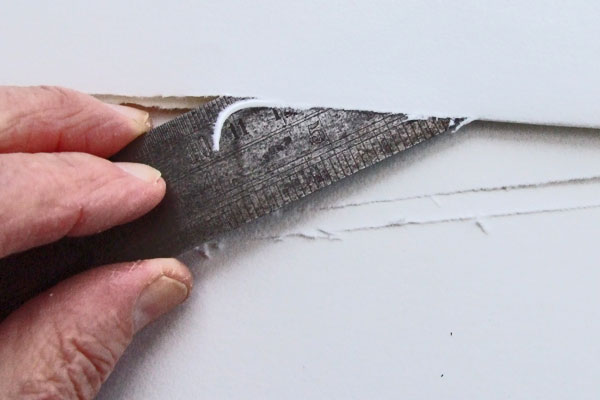
Flattening the slight wandering of a cobble-cut
Cobble-cutting with a very sharp knife can lead to slight ~ or serious ~ mishaps. I find it difficult to avoid them. I am not experienced or skilled enough! The simple glitches can take time to rectify. The bigger ones can be very expensive ~ as when slicing an exact length from a roll.

Here a sheet of creased 140gsm cartridge paper has been cobble-cut with a razor sharp pocket knife. The knife has wandered off course, and instead of cutting directly into the peak of the crease it has wandered slightly to one side. This leaves a little bump on one sheet. This can easily be flattened with the bone folder ~ as is happening, above. However the smooth finish is gone, the torn edge appearance of the cobble cut is there ~ even if with little emphasis ~ and presents a casual appearance that involves an extra job with the folder ~ or finger nail ~ to sort it.
Greater mishaps can occur if a sharp knife is allowed to wander further away from the crease [120095].
In both of the two samples, above, one of the features of cobble-cutting is being lost. To me one of the purposes of cobble-cutting is to give a slightly rustic look ~ something midway between a sharp knife cut into a cutting board and at the other extreme the appearance of a deckle edge. Because a cobble cut can go wrong it is best to avoid it unless you can tolerate a mishap.
The best tool, I find, is to use a fairly blunt knife and minimise the slicing effect ~ along the axis of the cut ~ and maximise the tugging ~ dragging at right angles to the crease. This latter technique requires frequent sawing motions to avoid the knife coming away from the paper.
The answer is not to use a sharp knife, and not to let it slice if you do. To explain this I have adopted a local definitions of slicing, tearing, cutting, ripping, drawing.
If using a really blunt tool, as in the examples below, wisps of paper can emerge. If these are evenly spread along the length of the crease they can be removed, leaving quite an attractive result. Otherwise it is quite uneven.


I surmise that the reason this cut produces whiskers is that the two corners of the steel rule are each cutting the paper at the same time. This double the effort required ~ it can be quite considerable when dealing with thick handmade papers
